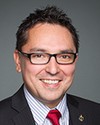moved that Bill C-61, An Act to give effect to the Anishinabek Nation Education Agreement and to make consequential amendments to other Acts, be read the second time and referred to a committee.
Mr. Speaker, I rise today to speak to Bill C-61, and I do so here on the traditional territory of the Algonquin people. This bill will implement an agreement that creates the Anishinabek education system, designed by Anishinabek first nations for Anishinabek students.
I would like to note that Grand Council Chief Madahbee and a large delegation of chiefs and community members from participating Anishinabek communities are here on Parliament Hill to witness the passage of this historic legislation.
This summer, I had the great honour of travelling to the Chippewas of Rama First Nation to sign the momentous agreement that led to this bill.
It was a beautiful ceremony.
There was a large circle of chiefs and youth representatives in their regalia. Proudly looking on were the education directors. Beautifully carved signing trays were circulated around the circle, and we signed this agreement in the circle.
The day had begun with a sunrise ceremony, the sacred fire by the water, watching the beautiful sunrise from the east, and the elder speaking in his language, Anishinabemowin.
As we came out of the darkness into the light, I spotted two Anishinabek youth on the opposite side of the circle wearing black sweatshirts with a medicine wheel and the words “Proud to be Anishinabek”. On one arm it said “Stand Strong”; on the other arm it said “Walk Tall”. It was so poignant. Only one generation ago young people were made to feel ashamed of speaking their own language at school, ashamed to be indigenous.
That was completely unacceptable, and it was also destructive.
We know that when young people have a secure personal cultural identity, they have better health, education, and economic outcomes. For these young people, being proud to be Anishinabek is the most powerful antidote that we have to racism and ignorance in this country.
Everything that we are speaking about today is ultimately about the young people, their education, their opportunities, their future, but also our future. It is about righting the wrongs of the past, ensuring that children can once again learn in a culturally safe way, with first nations-led educators in first nations-led schools and in first nations-led education systems.
I would like to take a moment to thank all of those who have brought us to this point today. It is especially fitting to acknowledge the late Merle Pegahmagabow, who led this important negotiation for many years. Merle has gone to the spirit world, and as with the other Anishinabek ancestors, we know he is here with us, guiding our work. I also want to acknowledge the Kinoomaadziwin Education Body, and acknowledge the hard work of the negotiating teams for Canada and the Anishinabek Nation.
This negotiated agreement is the first of its kind in Ontario. It is the largest education agreement and largest self-government agreement in Canada. Of course, it is also an agreement that can and will expand as other communities opt in, if and when they so choose to.
The Anishinabek Nation education agreement is a concrete step toward self-government.
It is a tangible example of a renewed relationship based on the recognition of rights, respect, co-operation, and partnership. Today we get to demonstrate what a true partnership looks like. This is the path forward for Canada, Ontario, as well as first nations governments.
The agreement supports the vision of the participating first nations of a quality Anishinabek education system that will promote Anishinabek culture and language, and improve educational outcomes for Anishinabek students. Most importantly, the decision-making power on education will rest exactly where it belongs, in the hands of first nations.
It was 20 years ago that the Mi'kmaq in Nova Scotia decided to take over their education system. Eskasoni Chief Leroy Denny has said that it was on that day he decided to become a teacher. At that time, their secondary school graduation rate was at 30%. Today, the Mi'kmaq education system in Nova Scotia has a secondary school graduation rate of about 90%, a higher rate than the non-indigenous population in Canada. The evidence is clear: first nations-led and first nations-governed education systems achieve better results for first nations students.
Already, at Siksika First Nation in Alberta, children from Calgary are being bused from the town to the Crowfoot School on the reserve for a better education, one that is culturally safe and taught by a faculty, of whom more than 80% are members of the Siksika Nation.
Today, we are enabling and accelerating a self-determination agreement, not just because it is the right thing to do, but also because it simply produces better results for indigenous people and the whole country.
From coast to coast to coast, there is a consensus that indigenous youth want to be rooted in their language and their culture.
They want to be competent on the land and on the water. They want to learn from elders. They are questioning industrial-era agricultural school days from 9 a.m. to 3:30 p.m. and a school year in which the students are off all summer, yet are marked absent during goose and moose season when they go on the land with their families. They recognize that the indigenous pedagogy of learning by doing is the way they learn best. Senator Murray Sinclair has said that it was education that got us into this mess, and it will be education that gets us out of this mess.
Therefore, today, together in partnership, we chart this way forward and together we can make Canada a better place for indigenous children. Chi-miigwech to Grand Council Chief Madahbee and Deputy Grand Council Chief Glen Hare and the 23 Anishinabek communities for their leadership and persistence in arriving at this historic education self-government agreement. Today is an inspiration for ReconciliAction for all of Canada.








